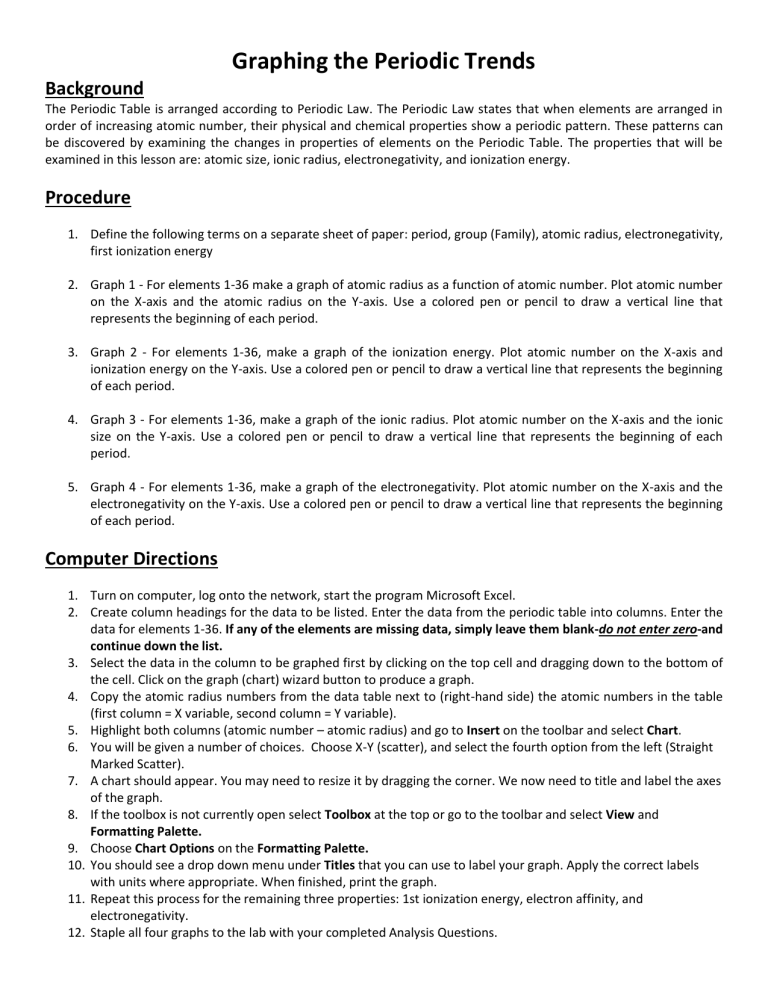Graphing Periodic Trends - Waterford Public Schools

Graphing the Periodic Trends
Background
The Periodic Table is arranged according to Periodic Law. The Periodic Law states that when elements are arranged in order of increasing atomic number, their physical and chemical properties show a periodic pattern. These patterns can be discovered by examining the changes in properties of elements on the Periodic Table. The properties that will be examined in this lesson are: atomic size, ionic radius, electronegativity, and ionization energy.
Procedure
1.
Define the following terms on a separate sheet of paper: period, group (Family), atomic radius, electronegativity, first ionization energy
2.
Graph 1 - For elements 1-36 make a graph of atomic radius as a function of atomic number. Plot atomic number on the X-axis and the atomic radius on the Y-axis. Use a colored pen or pencil to draw a vertical line that represents the beginning of each period.
3.
Graph 2 - For elements 1-36, make a graph of the ionization energy. Plot atomic number on the X-axis and ionization energy on the Y-axis. Use a colored pen or pencil to draw a vertical line that represents the beginning of each period.
4.
Graph 3 - For elements 1-36, make a graph of the ionic radius. Plot atomic number on the X-axis and the ionic size on the Y-axis. Use a colored pen or pencil to draw a vertical line that represents the beginning of each period.
5.
Graph 4 - For elements 1-36, make a graph of the electronegativity. Plot atomic number on the X-axis and the electronegativity on the Y-axis. Use a colored pen or pencil to draw a vertical line that represents the beginning of each period.
Computer Directions
1.
Turn on computer, log onto the network, start the program Microsoft Excel.
2.
Create column headings for the data to be listed. Enter the data from the periodic table into columns. Enter the data for elements 1-36. If any of the elements are missing data, simply leave them blank-do not enter zero-and
continue down the list.
3.
Select the data in the column to be graphed first by clicking on the top cell and dragging down to the bottom of the cell. Click on the graph (chart) wizard button to produce a graph.
4.
Copy the atomic radius numbers from the data table next to (right‐hand side) the atomic numbers in the table
(first column = X variable, second column = Y variable).
5.
Highlight both columns (atomic number – atomic radius) and go to Insert on the toolbar and select Chart.
6.
You will be given a number of choices. Choose X-Y (scatter), and select the fourth option from the left (Straight
Marked Scatter).
7.
A chart should appear. You may need to resize it by dragging the corner. We now need to title and label the axes of the graph.
8.
If the toolbox is not currently open select Toolbox at the top or go to the toolbar and select View and
Formatting Palette.
9.
Choose Chart Options on the Formatting Palette.
10.
You should see a drop down menu under Titles that you can use to label your graph. Apply the correct labels with units where appropriate. When finished, print the graph.
11.
Repeat this process for the remaining three properties: 1st ionization energy, electron affinity, and electronegativity.
12.
Staple all four graphs to the lab with your completed Analysis Questions.
Data Table
Element
Symbol
Mn
Fe
Co
Ni
Sc
Ti
V
Cr
Cl
Ar
K
Ca
Al
Si
P
S
Cu
Zn
Ga
Ge
As
Se
Br
Kr
H
He
Li
Be
B
C
N
O
F
Ne
Na
Mg
Atomic
Radius (pm)
184
176
171
166
161
156
152
149
118
111
98
88
79
71
243
194
145
142
136
125
114
103
94
88
53
31
167
112
87
67
56
48
42
36
190
145
Atomic
#
25
26
27
28
21
22
23
24
17
18
19
20
13
14
15
16
29
30
31
32
33
34
35
36
4
5
6
7
1
2
3
8
9
10
11
12
633
659
651
653
717
762
760
737
577
786
1011
999
1251
1520
419
590
Ionization
Energy
(kJ/mol)
1311
2371
520
899
800
1086
1402
1313
1680
2080
496
737
745
906
579
762
944
941
1139
1350
Electronegativity *
(Pauling Scale)
Ionic
Radius*
(pm)
60
31
20
15
171
140
136
95
65
50
41
212
184
181
72
72
96
88
62
53
222
198
195
133
99
106
96
88
81
75
74
1.36
1.54
1.63
1.66
1.55
1.83
1.88
1.91
1.61
1.90
2.19
2.58
3.16
0.82
1.00
1.90
1.65
1.81
2.01
2.18
2.55
2.96
3.00
2.20
0.98
1.57
2.04
2.55
3.04
3.44
3.98
0.93
1.31
Questions
A trend is an observation, NOT an explanation! It is fine to state the trend itself, but you must also go further by explaining what causes the observed trend. Remember, these trends emerge as a result of a pattern in element properties. Think hard about the change in atomic structure as one moves across and down the Periodic Table!
Please answer all questions on a separate sheet of paper. Write complete sentences to receive full credit.
1.
Based on your graphs, what is the trend in atomic radius across a period? Down a family? Using your knowledge of atomic structure, what is the explanation for this trend?
2.
Based on your graphs, what is the trend in ionization energy across a period? Down a family? Using your knowledge of atomic structure, what is the explanation for this trend?
3.
Based on your graph, what is the trend in electronegativity across a period? Down a family? Using your knowledge of atomic structure, what is the explanation for this trend?
4.
Based on your graph, what is the trend in ionic radius across a period? Down a family?
5.
Compare the graphs for ionic and atomic radii. a.
In general, what happens to metals when they form an ion? b.
What happens to nonmetals when they form an ion? c.
How does this information support the trends you see?
6.
For each Periodic Table trend explored in this activity, hypothesize the element that has the greatest value and the smallest value.
Justify your answers.
7.
Using an activity series, what can you deduce about the relationship between ionization energy and reactivity of metals? Why do you think the relationship you see in the graph is contradictory to what you understand about the activity series?
8.
For each property, write a summary below the title of your graph that explains the trend as you move across a period and down a group. Be sure to include the explanation for the observations you wrote in #1-4!







